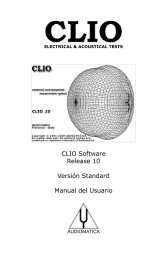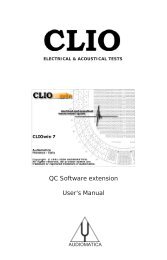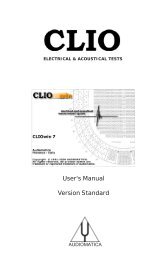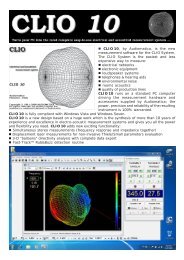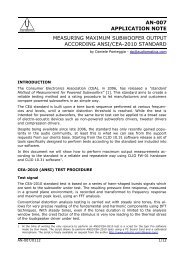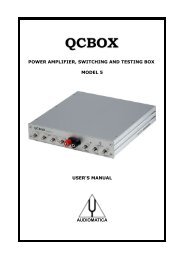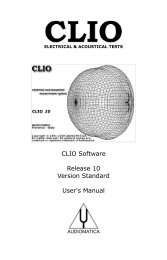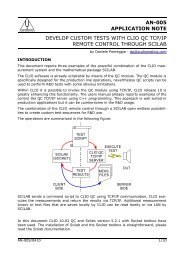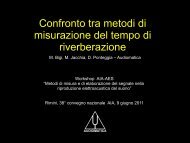CLIOwin 6.5 PCI User's Manual - Audiomatica Srl
CLIOwin 6.5 PCI User's Manual - Audiomatica Srl
CLIOwin 6.5 PCI User's Manual - Audiomatica Srl
You also want an ePaper? Increase the reach of your titles
YUMPU automatically turns print PDFs into web optimized ePapers that Google loves.
9.5 AVERAGING<br />
Averaging plays a very important role in FFT and RTA analysis. It is vital when analyzing<br />
signals buried with noise. It is also important when taking spatially averaged measurements.<br />
<strong>CLIOwin</strong> has flexible averaging capabilities. Averaging basically means adding<br />
and dividing for the number of additions made. To start an averaged FFT measurement<br />
you need to set a number bigger than one in the Target Average drop down; otherwise<br />
you have a continuously refreshing single measurement that will continue until the Stop<br />
button is pressed. It is possible to choose between linear and exponential averaging.<br />
The instrument behaves differently in the two averaging modes. In linear averaging the<br />
measurement is continued until the target is reached, then it automatically stops. What<br />
you got is exactly what we just explained. In exponential averaging the measurement<br />
never stops. When the target is reached the averaging continues relying on a<br />
mathematical formula which discards the oldest acquisitions and gives more and more<br />
importance to newer ones. The exponential averaging is the default one.<br />
As an example Fig. 9.4 compares a single 1kHz sinusoid FFT analysis and 100 averages<br />
one.<br />
0.0<br />
CLIO<br />
0.0<br />
CLIO<br />
dBV<br />
dBV<br />
-30.0<br />
-30.0<br />
-60.0<br />
-60.0<br />
-90.0<br />
-90.0<br />
-120.0<br />
-120.0<br />
-150.0<br />
-150.0<br />
0.00 2000 4000 6000 8000 10000 12000 14000 16000 Hz 18000 20000 0.00 2000 4000 6000 8000 10000 12000 14000 16000 Hz 18000 20000<br />
Figure 9.4<br />
This is a classical example of signal buried with noise: the sinusoid's 9th harmonic is<br />
clearly visible after 100 averages, but invisible for a single acquisition.<br />
Another important feature, when averaging, is the possibility of continuing averaging<br />
after a measurement is stopped, has reached its target or a previous measurement has<br />
been loaded from disk. <strong>CLIOwin</strong> has this capability when selecting continue in the drop<br />
down menu available aside the Go button (Fig.9.5).<br />
Figure 9.5<br />
Selecting the continue option allows, as an example, for spatially averaged measurements.<br />
Fig. 9.6 shows two 1/3 octave RTA measurements of a small HT satellite at<br />
listening position: the black one is a single 10 averages measurement taken on axis;<br />
the red one is, instead, built, using the continue option, adding a total of eleven 10<br />
averages measurements taken moving from -25 degrees left to +25 right of the speaker<br />
itself.<br />
82 Chapter 9 - FFT




